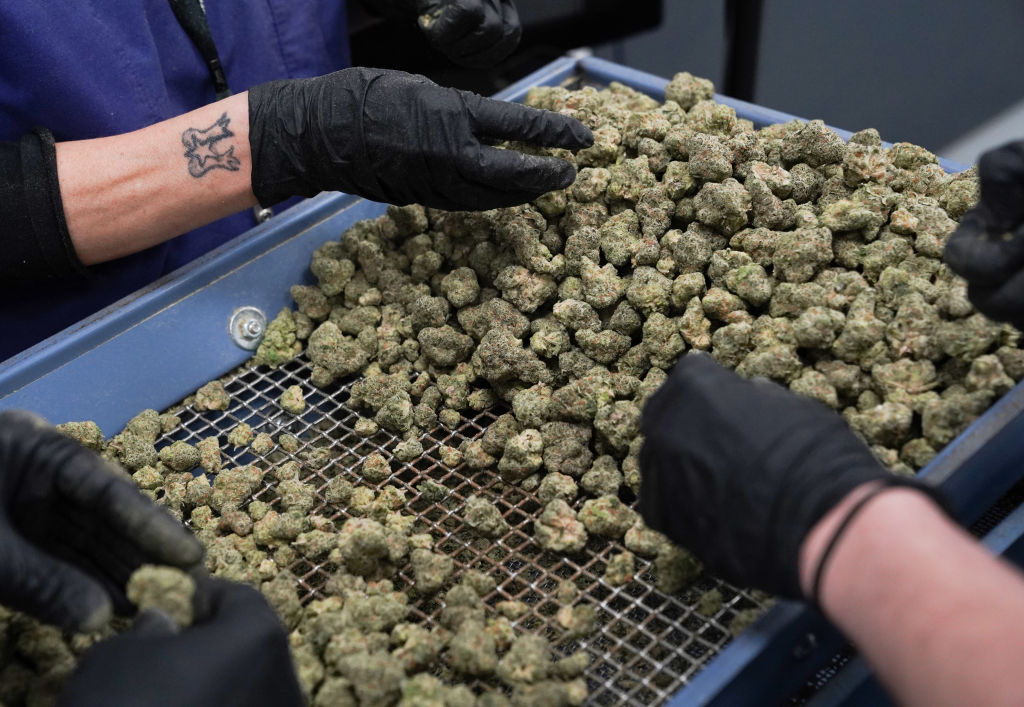
There was something sort of desperate in Maryland Gov. Wes Moore’s announcement last month that he had signed an executive order pardoning more than 175,000 Marylanders for misdemeanor marijuana and drug paraphernalia possession. Moore’s office, of course, painted the pardon as “historic.” But there’s a deep disparity between presentation and reality, between the idea of a historic blow for racial justice and the facts on the ground.
The order will likely improve some of its beneficiaries’ employment prospects, although only about a quarter will have their records automatically expunged. It will result in no decarceration, because no Marylander is currently imprisoned on marijuana charges. And because the pardons stretch back to offenses in the 1980s, an unknown fraction of recipients are no longer alive to enjoy their new status. These tepid results make Moore’s pardon feel more like an attempt to reclaim the excitement that came with recreational marijuana legalization two years ago. “See,” it all but says, “legal weed is still something we can feel good about!”
That was probably how Marylanders felt in 2022, when more than 67 percent of them voted to legalize recreational use of marijuana. (I was, full disclosure, among the nearly 33 percent who voted against.) Today, though, they are more ambivalent. In a recent Washington Post–University of Maryland poll, opinions on legalization’s effects were divided. Among registered voters, 31 percent think legalization has been a good thing, while an equal 31 percent think it’s been bad. Thirty-four percent say the change has been neither good nor bad.
While voters are split on legalization in principle, in practice they seem to want little to do with it. Just 15 percent report buying marijuana products since legalization. And a narrow majority would not want a dispensary in their neighborhood. Call it marijuana NIMBYism—everyone else can contend with dispensaries by their kids’ schools and clouds of smoke on their walks, but not me, thanks.
Like Moore’s pardon, these findings reflect the contrast between the dream of legalization and its bleary reality. When they had not lived with legal, commercialized marijuana, it was easy for Marylanders—and for the more than 180 million Americans who live in a legal jurisdiction—to imagine it would be all upside. Advocates of legalization promised not only weed without the fear of arrest, but an end to mass incarceration, and business opportunities for those once victimized by the War on Drugs. And to be fair, the downsides, now that they’ve materialized, are not catastrophic. But they make the cost-benefit math of legalization, which once seemed so clear, appear in hindsight far more tenuous.
Let’s recall that the case for legalization turned on a somewhat idealized vision of marijuana. Proponents routinely presented it as a relatively harmless plant, appropriate for the treatment of a wide range of maladies. Prohibition, by contrast, was portrayed as an irrational, racist practice that put millions of people in prison. The reality is not exactly the opposite, but more muddled. Marijuana, it turns out, is an addictive, risky substance. Legalizing its commercial sale causes more people to use it and increases levels of addiction. As a result, levels of harm increase.
There are health harms. Legalization is consistently associated with increases in hospitalizations from marijuana-related conditions, which can include respiratory depression, cardiovascular problems, cannabis-induced psychosis, and the repeated vomiting known as cannabis hyperemesis syndrome. Heavy marijuana use, particularly in adolescence, is associated with several mental health issues, most persuasively schizophrenia. There are the predictable harms of increasing the availability of an intoxicant. Recreational legalization has caused an additional 1,400 road deaths a year, by one estimate, and record high rates of employees testing positive for marijuana after workplace accidents.
There are also social harms. One analysis of recreational dispensaries in Chicago found that crime increased by roughly 30 percent in the surrounding one-third mile following the opening of a dispensary. A recent paper published by the Federal Reserve Bank of Kansas City found that following recreational legalization, states experienced on average a 17 percent increase in addiction, a 35 percent increase in chronic homelessness, and a 13 percent increase in arrests. And of course, there is the pervasive smell that has infected many legal jurisdictions.
Perhaps most significant—but least remarked upon—is the fact that many more people now spend many more hours stoned. In 1992, a recent paper found, fewer than a million Americans consumed marijuana on a daily or near-daily basis. In 2022, the equivalent figure was 17.7 million, a figure that for the first time exceeded the number of daily drinkers. Not all of these people are unhappy with their daily use, of course. But an estimated 19 million Americans meet the criteria for marijuana addiction, characterized by “continued use of cannabis despite significant negative impact on one’s life and health.” Perhaps people believe they are happy waking and baking, but it’s not clear we’re better off as a society when 17 million of our fellow citizens do so.
It should be acknowledged that none of these harms alone is necessarily disastrous. At 1,400, the number of marijuana-related road deaths is still fewer than those attributable to alcohol (although many more people drink than smoke weed). Marijuana smoking might cause schizophrenia, but so too might owning a cat. Millions of Americans spending their days in a haze is not exactly good, but unless they crash a car or develop lung cancer, they aren’t dying from their marijuana use.
Policy, after all, is all about trade-offs, and legalization has its benefits as well as its costs. While marijuana-involved incarceration is almost nonexistent, recreational legalization is consistently associated with large reductions in marijuana possession arrests, which once swept up hundreds of thousands of Americans a year. There are also what we might call “hedonic” benefits. If 19 million people used marijuana problematically in 2022, another 43 million used it without a use disorder. The enjoyment—and the rights—of those people get to count for something in the policy calculus.
But a reduction in possession arrests, possibly counteracted by an increase in total arrests, and casual entertainment for millions of Americans is a slim nail upon which to hang the legalizer’s hat. The ambivalence with which Marylanders, among others, approach the status quo is a perfectly rational response. Attempts to distract from the issue—like Moore’s pardon, or the Biden administration’s recent move to reclassify marijuana as a less-dangerous drug, which is mostly a giveaway to the state-legal industry—are trying to restore rapidly failing sense of moral certitude.
Indeed, states are finally starting to think twice about the wisdom of full, commercial legalization. New Hampshire’s efforts at legalization have gone down in legislative flames after Gov. Chris Sununu’s sensible proposal to have the state run stores proved a nonstarter. In Virginia, possession and home cultivation are legal, but Gov. Glenn Youngkin has blocked the creation of a legal market—another strategy that might minimize harm. And Oklahoma voters rejected a legalization ballot initiative last year, a decision rendered only somewhat less remarkable by the state’s relatively unregulated “medical” marijuana system.
People in each of these states have looked at their peers and not liked what they saw. Perhaps that’s rational—one of the blessings of federalism (and of federal prohibition limiting interstate commerce) is that it permits experimentation. Perhaps they will, in time, change their minds. But what’s certain is that as Americans have grown more familiar with legal weed, and with some of its negative effects, it has become harder and harder to sustain the fiction that rendered legalization possible in the first place.

